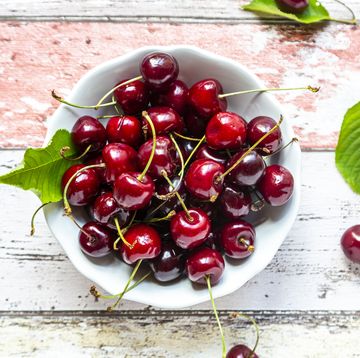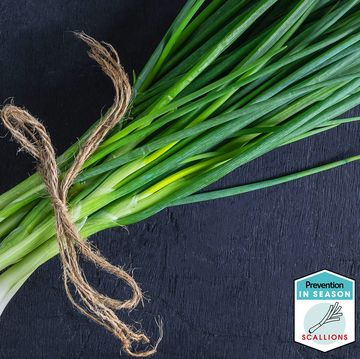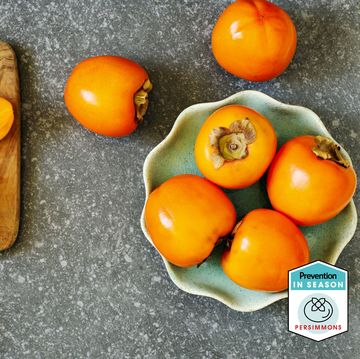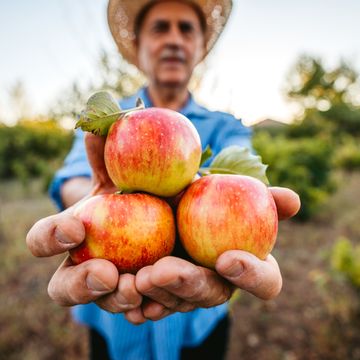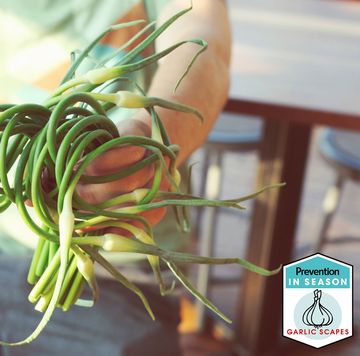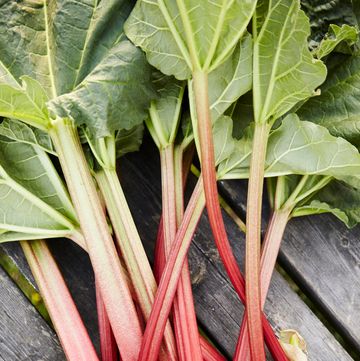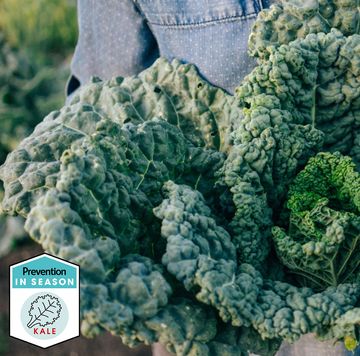Autumn means the markets are bursting with winter squash and root vegetables that last long, hold up nicely to strong flavors, and are super versatile in an array of comforting dishes. But alongside the parsnips and cabbage of the season is an other-worldly-looking vegetable that’s equally as delicious and deserves your culinary attention. We chatted with experts to explain what celery root is, if celery root is good for you, and how to use celery root so you can make the most out of this amazing cold-weather vegetable.
What is celery root?
Let’s get this out of the way first: is celery root actually the root of celery? Not exactly.
“Aside from being one of my favorite veggies ever, celery root is a cousin of the celery we all know and love,” explains Alison Cayne, founder and CEO of Haven’s Kitchen, a former event space for culinary classes that now sells globally-inspired sauces. “Rather than cultivated for the stalk, it’s grown for the bulbous root.”
So, celery root is related to the green stalks we snack on, but aren’t quite the same. In fact, the celery plant we grow for the stalk has a very little root we don’t typically eat and the celery plant we grow for the root has some very small stalks we also don’t usually eat, explains Juliet Glass, director of communications at FRESHFARM, a non-profit that operates producer-only farmers’ markets in the Mid-Atlantic region.
This root vegetable is typically round, with knobby features, and is a light, tan color, says Lee Jones, a farmer behind The Chef’s Garden. They’re not the most attractive vegetable, adds Glass, and often words like gnarly, knobby, furry, and hairy are used to describe the exterior. Though it can be off putting and a bit of work to clean, Glass says it’s worth the effort.
It’s most commonly called celery root, but it may also be listed as celeriac, turnip-rooted celery, and knob celery, Jones notes. The flavor is very mild, slightly sweet and nutty, and doesn’t have any bitterness, says Debra Moser, co-founder of Central Farm Markets in Washington D.C.
Though you may find celery root at your local farmers market or specialty store, it’s not as common in suburban supermarkets, says Brian Contreras, chef and Miraval Resorts and Spas’ director of culinary experiences. But, there is the possibility you’d see it near the other root vegetables like rutabagas and turnips, he notes, just be sure you know what you’re looking for.
And if you are lucky enough to spot it, the best time to snag some is in the fall through spring, starting in October and ending in April, says Jones. Just be sure to look for a firmer, heavier celery root without any soft spots, he says.
Celery root nutrition
About one cup of celery root contains:
- 66 calories
- 2 g protein
- 14 g carbohydrates
- 3 g fiber
- 0.5 g fat
- 6.4 mcg vitamin K
- 156 mg sodium
- 2.5 g sugar
Celery root benefits
“It’s very nutritious and provides fiber, vitamin C, potassium, and manganese,” says Catherine Perez, M.S., R.D., registered dietitian and owner of Plant-Based R.D. blog. “It is also an excellent source of vitamin K and antioxidants.”
The high vitamin K is a stand-out nutrient to Perez, and she notes it provides extra support to strengthen bones and can even help reduce the risk of cancer. Additionally, celery root is also a great, lower-carb swap and low-glycemic index option for those looking to cut down on their carbohydrates. “Making mindful swaps, like celery root for potato, is a great way to be creative and inspire balance in your ingredient choices,” adds Contreras.
Celery root uses
Though it can look a little intimidating, celery root is super versatile and can be a delicious addition to your fall and winter cooking, Contreras says. He notes there are wrinkles on the skin that can take in dirt, so you can choose to peel the celery root. But, many people like to keep the skin on and just give it a good scrub to ensure you’re getting all the nutrients you’d otherwise lose, he says. Be sure to ask your farmer how they like to cook it, Moser suggests, but give these expert-approved ideas a try in the meantime:
- Shred it. Perez says she likes to shred celery root raw into slaws to switch things up in the cooler months. Moser adds they’re great sliced raw in salads, too.
- Mash it. Peel the celery root, boil it with aromatics, and treat it like you would mashed potatoes, Contreras says.
- Roast it. Like any other heart root vegetable, Perez likes to cube it up, toss it on a sheet pan, and roast it with garlic, thyme, avocado oil, salt, and pepper. Serve it as a side dish or add it to winter buddha bowls and vegetable tacos, Jones adds.
- Blend it. Jones likes to make the most of fall’s vegetables with this celery root soup.
- Pickle it. Like many other root veggies, Contreras says you can pickle sliced celery root in your favorite brine and add it to salads.
- Make it into a sauce. Glass likes to give the celery root a quick blanch and mix into a mayonnaise and mustard mixture and serve alongside seafood.
- Fry ‘em. Even if you don’t actually put them in a fryer (though you could), Perez says celery root makes for a delicious fry alternative. Cut them into strips that resemble French fries and roast them in the oven or in the air fryer. Contreras notes you can dust them with some potato starch for a crispier bite.
- Grill it. Slice celery root into steaks and grill them, suggest Contreras. This can add some fun colors and textures to your plate.
- Bake it. Glass says her favorite thing to make with celery root is a potato and celery root gratin, which is a cheesy, delicious side dish.
And if you aren’t getting to cook your celery root as soon as you bring it home, Jones suggests storing it in the vegetable drawer of your refrigerator or in a plastic bag in the fridge. Don’t wash it until you’re ready to use it, and it can last about three weeks, he says.

Arielle Weg is the associate editor at Prevention and loves to share her favorite wellness and nutrition obsessions. She previously managed content at The Vitamin Shoppe, and her work has also appeared in Women’s Health, Men’s Health, Cooking Light, MyRecipes, and more. You can usually find her taking an online workout class or making a mess in the kitchen, creating something delicious she found in her cookbook collection or saved on Instagram.


